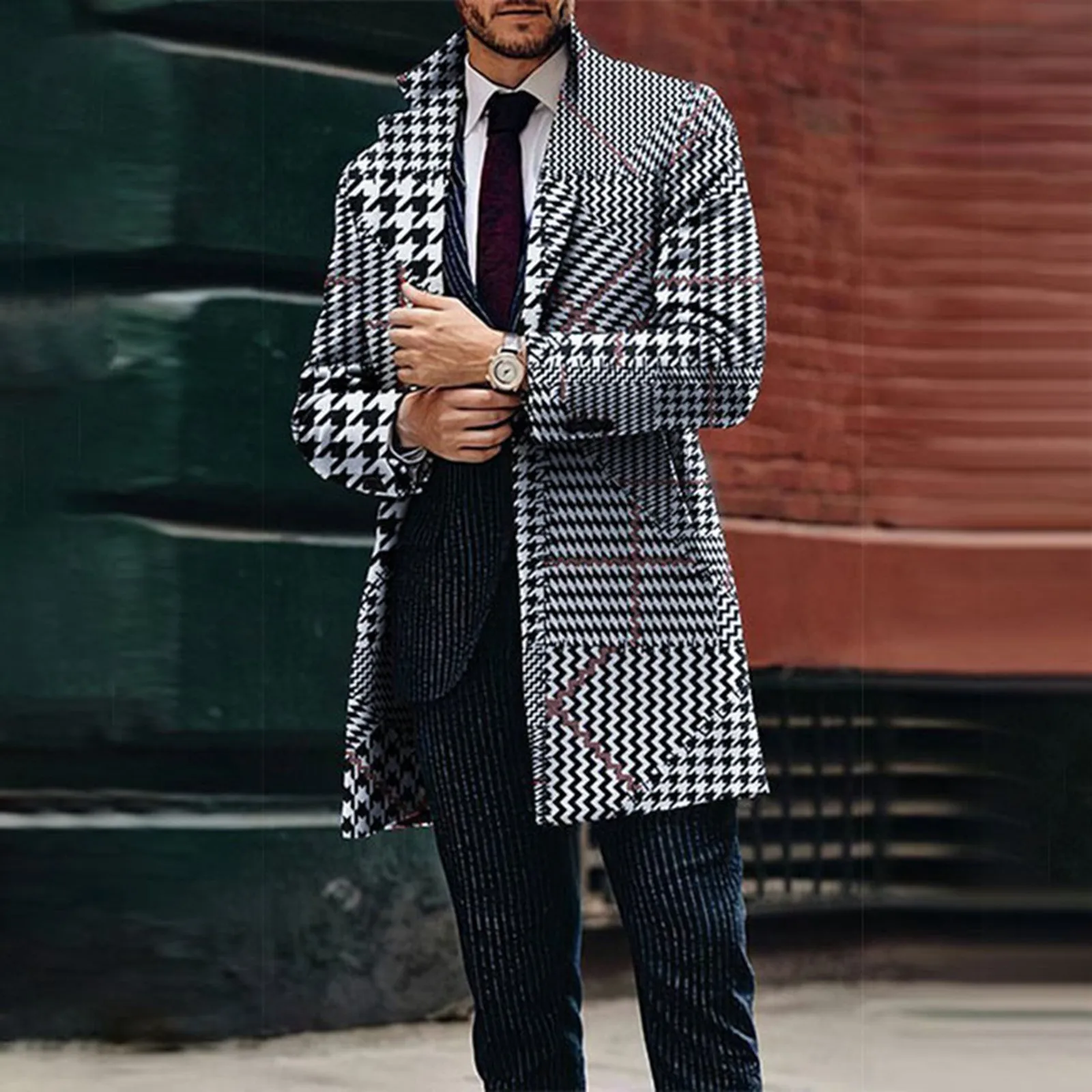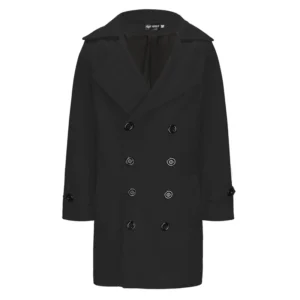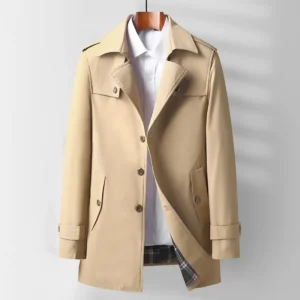Navigating Changing Temperatures: Why the Right Transitional Topcoat Matters
The challenge of dressing appropriately during spring and fall is all too familiar – leaving home in brisk morning air only to find yourself overheated by afternoon. These transitional seasons demand outerwear that can handle temperature swings of 20-25 degrees in a single day (typically between 40-65°F/4-18°C).
What sets a true “transitional topcoat” apart from winter options is its versatile nature. The ideal transitional coat offers:
- Moderate warmth without causing overheating
- Protection from unexpected showers and wind
- Versatility to layer or wear alone as temperatures fluctuate
- Appropriate weight that doesn’t burden you as the day warms
Selecting the right coat depends greatly on understanding proper coat length for variable temperatures and weather conditions. Material selection plays a crucial role – too heavy and you’ll overheat, too light and you’ll shiver through morning commutes.
When evaluating transitional topcoats, we prioritize:
– Material quality and appropriate weight
– Construction durability and details
– Weather resistance capabilities
– Styling versatility across different outfits
– Overall value proposition
At Metro Cloak, we specialize in outerwear that performs throughout changing seasons. Our team evaluates hundreds of coats annually to identify those that truly excel in variable conditions. The recommendations below represent the most versatile, well-constructed options for navigating unpredictable transitional weather.
Our Top Picks: Best Men’s Topcoats for Transitional Weather
Here’s a quick reference guide to our top transitional topcoat recommendations:
| Coat Style | Standout Feature | Primary Material | Price Range |
|---|---|---|---|
| Classic Wool Blend Topcoat | Most versatile styling options | 70% Wool / 30% Synthetic | $$$ |
| Technical Weather-Resistant Topcoat | Best for unpredictable conditions | Performance Fabrics with DWR | $$$$ |
| Trench Coat | Superior rain protection | Cotton Gabardine or Tech Blend | $$-$$$ |
| Lightweight Unstructured Topcoat | Ideal for warmer transitions | Cotton/Wool Blend | $$ |
| Car Coat | Best for active lifestyles | Wool Blend or Technical Fabric | $$ |
These selections cover a range of style preferences and weather scenarios you’ll encounter during transitional months. Understanding how different coat lengths work for transitional weather will help you select the option best suited to your needs and body type.
Each coat has been evaluated across our key criteria of material quality, construction, weather resistance, versatility, and value to ensure they deliver reliable performance when temperatures fluctuate.
The Classic Wool Blend Topcoat: Timeless Elegance for Mild Transitional Days
The wool blend topcoat represents the gold standard for transitional weather for good reason. Its balance of temperature regulation, moderate protection, and timeless style makes it exceptionally versatile during seasonal shifts.
Materials:
The ideal transitional wool blend typically contains:
– 60-80% wool for natural temperature regulation
– 20-40% synthetic fibers (polyester/nylon) for durability and shape retention
– Fabric weight between 12-16 oz (340-450g) – substantial enough for protection without winter-coat heaviness
Construction Details:
– Half-lining rather than full lining allows better breathability
– Reinforced shoulder seams prevent distortion from light rain
– Notched lapels that can be turned up against wind when needed
– Natural shoulder construction allowing room for layers
Performance:
This coat excels in moderate conditions between 45-65°F (7-18°C). The natural properties of wool provide:
– Effective wind resistance without complete blocking
– Light water resistance (can handle brief showers)
– Excellent temperature regulation as conditions change
Explore our men’s wool overcoat collection for options that combine traditional styling with performance details for transitional seasons.
Care Considerations:
– Dry clean only, typically 1-2 times per season
– Brush with garment brush rather than frequent cleaning
– Allow to fully dry if caught in light rain
The classic wool blend topcoat represents an investment piece that, with proper care, will serve you through countless transitional seasons with timeless style.
The Technical Weather-Resistant Topcoat: Modern Protection with Style
For those facing truly unpredictable transitional weather, technical fabric topcoats bridge the gap between performance outerwear and sophisticated styling. These innovative coats incorporate advanced materials while maintaining a refined silhouette.
Materials Analysis:
– Premium technical fabrics with DWR (Durable Water Repellent) treatments
– Breathable membrane technology allowing moisture vapor transfer
– Strategic insulation mapping for temperature regulation without bulk
– Typically lightweight (20-30% lighter than traditional wool options)
Construction Highlights:
– Taped or bonded seams preventing water penetration
– Ventilation features like underarm eyelets or back vents
– Reinforced stress points at shoulders and pockets
– Hidden storm cuffs or adjustable sleeve openings
Weather Performance:
These coats excel when conditions vary dramatically throughout the day:
– Water resistance ratings of 5,000-10,000mm (handles moderate rain)
– Wind protection equivalent to 25-35mph gusts
– Breathability ratings allowing 5,000-8,000g/m²/24hrs of moisture transfer
– Effective temperature range of 40-60°F (4-15°C)
Explore our men’s topcoats collection for technically advanced options that don’t sacrifice style for performance.
While these coats typically command premium prices, their versatility across multiple weather conditions and seasonal transitions makes them particularly valuable for commuters and frequent travelers who can’t predict their weather exposure.
The Versatile Trench Coat: Iconic Protection for Rainy Transitional Seasons
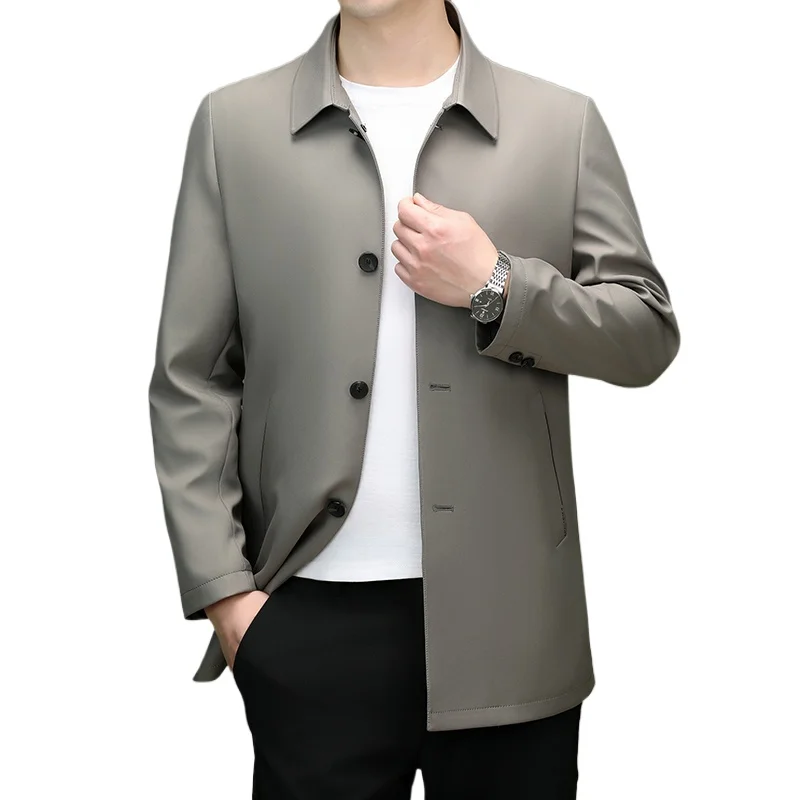
The trench coat has protected gentlemen from inclement weather since its military origins, evolving into the quintessential transitional rainwear option that balances functionality with refined style.
Materials Overview:
– Traditional cotton gabardine with tight weave for natural water resistance
– Modern versions incorporating technical fabrics or cotton/synthetic blends
– Water-resistant treatments providing 1-3 hours of rain protection
– Fabric weights ranging from 8-12oz (230-340g) depending on intended climate
Construction Details:
– Signature storm flaps directing water away from openings
– Epaulets originally designed for military insignia now adding shoulder structure
– Belted waist allowing adjustable fit for different layering needs
– Gun flap on right shoulder preventing water seepage
Weather Performance:
The trench excels in classic transitional challenges:
– Excellent wind protection due to double-breasted closure
– Superior rain resistance from overlapping fabric panels
– Moderate temperature regulation (45-65°F/7-18°C)
– Adaptable ventilation through adjustable features
When selecting the right trench, consider whether short vs long coat styles better suit your height and lifestyle needs. Longer trenches provide better rain protection, while shorter versions offer greater mobility.
Styling Versatility:
Few outerwear pieces transition as seamlessly between formal and casual settings. The trench works equally well over:
– Business suits and formal attire
– Business casual office wear
– Weekend casual outfits with jeans
This adaptability makes the trench coat particularly valuable during transitional months when social and professional occasions might require different levels of formality.
The Lightweight Unstructured Topcoat: Casual Sophistication for Warmer Transitions
For early spring days or mild fall weather, the unstructured topcoat offers an elegant solution that provides just enough protection without the weight or formality of traditional outerwear.
Materials Focus:
– Lightweight wool (7-10oz/200-280g) offering breathability
– Cotton blends providing casual appearance with moderate protection
– Technical blends incorporating performance features while maintaining drape
– Open-weave fabrics allowing air circulation during temperature fluctuations
Construction Details:
– Minimal lining (often just shoulders and sleeves) reducing overall weight
– Soft, natural shoulders without padding for relaxed silhouette
– Relaxed armholes accommodating layers without restriction
– Simplified internal construction reducing total weight by 30-40%
Performance Benefits:
These lighter options excel in:
– Superior breathability during active movement
– Effortless layering flexibility as temperatures change
– Comfortable wear during variable conditions (50-65°F/10-18°C)
– Excellent packability for travel (many can fold into carry-ons)
Styling Applications:
The unstructured topcoat bridges formal and casual with remarkable ease:
– Elevates business casual attire with refined finishing
– Complements weekend wear without appearing overdressed
– Transitions from day to evening as temperatures drop
– Layers comfortably over multiple clothing thicknesses
While these coats sacrifice some weather protection, their comfort and versatility make them ideal for milder transitional periods or urban environments where indoor/outdoor transitions occur frequently.
The Car Coat: Practical Shorter Length for Active Transitional Wear
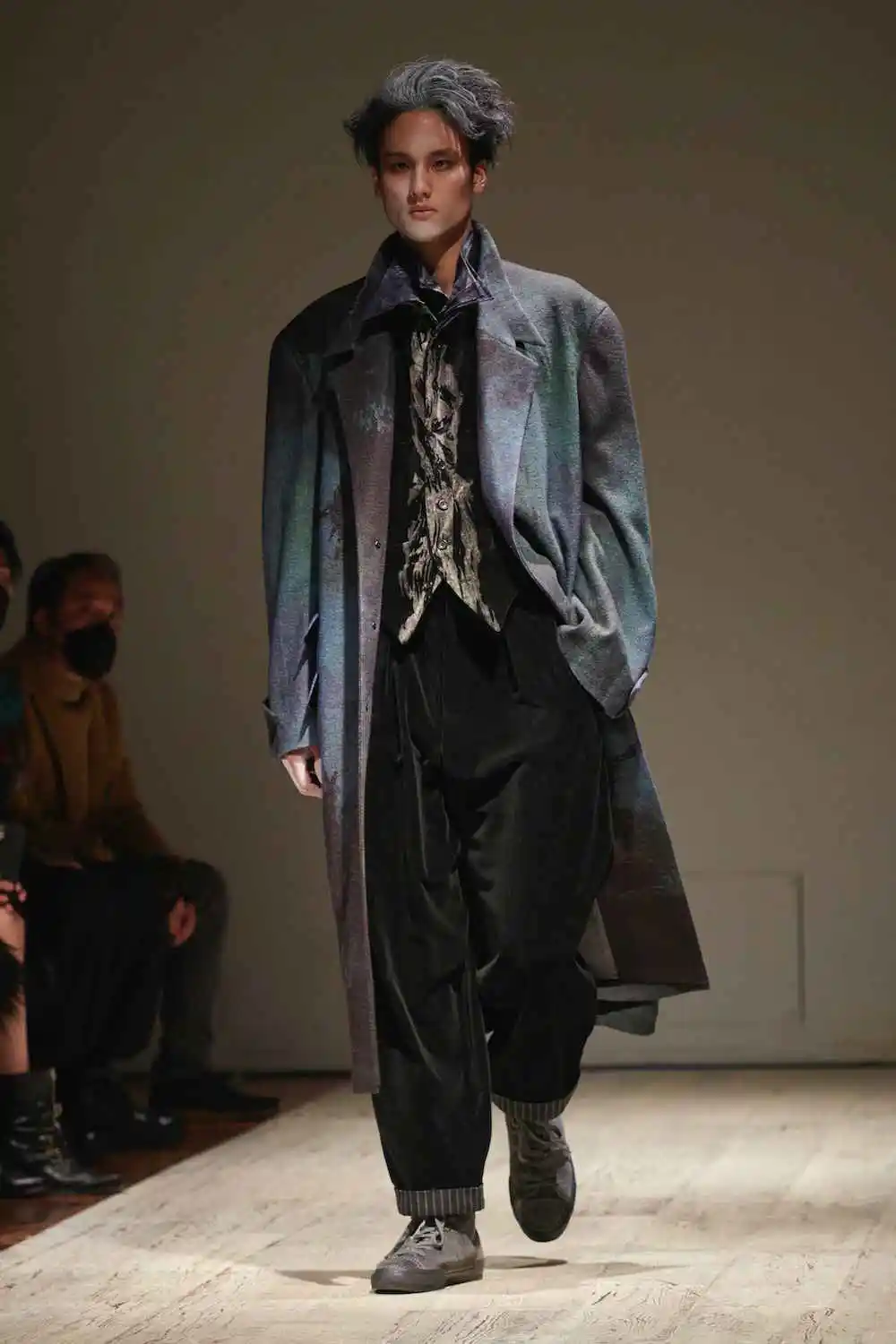
Originally designed for early automobile drivers who needed protection without movement restriction, the car coat has evolved into a practical transitional option for today’s active lifestyle.
Materials Spectrum:
– Traditional wool blends offering warmth without bulk
– Cotton twill providing casual durability
– Technical fabrics incorporating stretch and weather resistance
– Material weights typically 10-14oz (280-400g) balancing protection and mobility
Construction Highlights:
– Hip-length cut (typically 30-34 inches/76-86cm) allowing full movement
– Functional pocket design positioned for easy access when seated
– Split back panels or action pleats accommodating driving positions
– Simplified closure systems for one-handed operation
Performance Benefits:
The car coat’s shorter length provides distinct advantages:
– Unrestricted leg movement during active commuting
– Driving comfort without bunching or riding up
– Moderate weather protection focused on upper body
– Easy transitioning between indoor/outdoor environments
Discover our collection of men’s car coats designed specifically for active lifestyles during transitional seasons.
Modern Interpretations:
Today’s car coats blend historical functionality with contemporary features:
– Water-resistant treatments for unexpected showers
– Interior tech pockets protecting electronic devices
– Reflective details for evening visibility
– Streamlined silhouettes appropriate for professional settings
This style particularly suits commuters who transition between walking, driving, and public transportation during unpredictable weather.
Mens Double Breasted Pea Coat, Mens Wool Blend Coat, Mens Wool Pea Coat
Price range: $136.84 through $157.36 Select options This product has multiple variants. The options may be chosen on the product pageMens Cashmere Overcoat, Mens Hooded Winter Coat, Mens Wool Blend Coat
Price range: $128.72 through $139.68 Select options This product has multiple variants. The options may be chosen on the product pageMens Black Overcoat, Mens Black Wool Coat, Mens Wool Overcoat
$339.18 Select options This product has multiple variants. The options may be chosen on the product pageMens Grey Overcoat, Mens Wool Blend Coat, Mens Wool Overcoat
$201.28 Select options This product has multiple variants. The options may be chosen on the product pageMens Herringbone Coat, Mens Long Overcoat, Mens Wool Overcoat
Price range: $197.16 through $203.69 Select options This product has multiple variants. The options may be chosen on the product pageMens Long Overcoat, Mens Topcoats
Price range: $189.40 through $196.88 Select options This product has multiple variants. The options may be chosen on the product page
Key Features to Prioritize in Your Transitional Topcoat
When evaluating transitional outerwear, certain features dramatically impact performance across variable conditions:
Material Selection:
– Prioritize breathable natural fibers (wool, cotton) with synthetic blending for durability
– Look for tight weaves that block wind while allowing moisture vapor transfer
– Consider water-resistant treatments appropriate for your precipitation levels
– Optimal wool blend coat materials provide natural temperature regulation
Construction Elements:
– Adjustable features like belts, tab cuffs, and throat latches enhance adaptability
– Ventilation details (back vents, underarm eyelets) prevent overheating
– Removable liners or zip-out components extend seasonal versatility
– Reinforced stress points ensure durability during daily wear
Weather Resistance:
– Water repellency (suitable for brief showers) versus waterproofing (sacrifices breathability)
– Wind-resistant construction at openings (plackets, storm flaps)
– Strategic seam placement minimizing weather penetration points
Weight and Packability:
– Ideal transitional coats weigh 2-3 lbs (0.9-1.4 kg)
– Consider compressibility for travel or storage as temperatures change
– Evaluate fabric recovery after packing (some materials wrinkle less than others)
The best transitional topcoats balance these features without compromising on style or comfort across changing conditions.
How to Choose the Right Topcoat for Your Transitional Weather Needs
Selecting the perfect transitional topcoat requires assessing both your environment and personal needs:
Assess Your Local Climate:
Transitional seasons vary dramatically by region:
– Northeast/Midwest: Wider temperature swings requiring more versatility
– Pacific Northwest: Consistent rain protection prioritized
– Southern regions: Lighter options with excellent breathability
– Mountain areas: Layer-friendly designs for dramatic day-night temperature shifts
Consider Primary Usage:
– Daily commuting requires durability and consistent weather protection
– Formal occasions benefit from classic styling with moderate protection
– Casual weekends allow more functional, performance-oriented designs
– Travel needs emphasize packability and wrinkle resistance
Personal Factors:
– Your temperature sensitivity affects optimal coat weight
– Activity level determines breathability requirements
– Layering preferences influence ideal sizing
– Finding the perfect coat length for your height ensures proportional appearance
Budget Considerations:
Quality transitional coats typically fall into:
– Entry-level ($150-250): Basic functionality with simplified construction
– Mid-range ($250-400): Enhanced materials with improved weather performance
– Premium ($400+): Superior materials, construction details, and longevity
Investing appropriately based on your climate challenges and wearing frequency will ensure your satisfaction across multiple seasons.
The Art of Layering with Your Transitional Topcoat
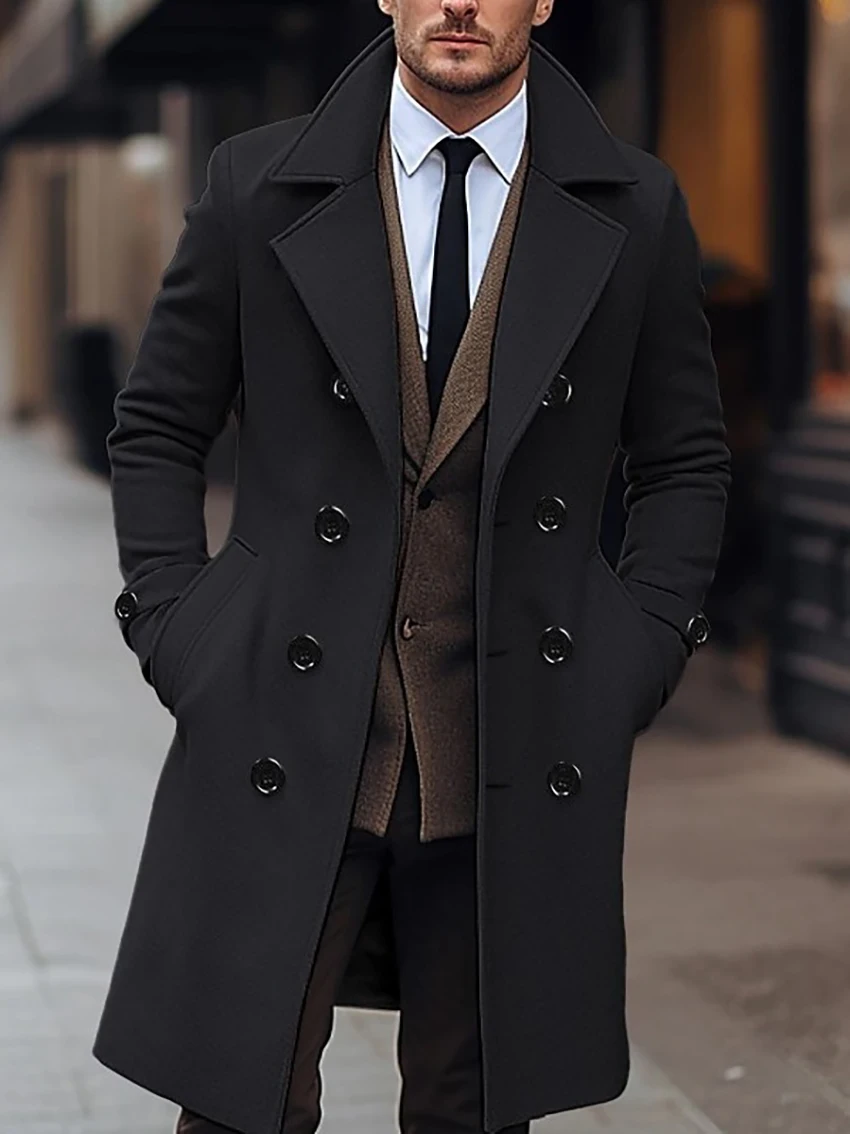
Mastering layering transforms a single topcoat into a season-spanning system that adapts to daily temperature fluctuations:
Strategic Layering Principles:
– Build from thin, moisture-wicking base layers
– Add insulating mid-layers that trap warm air
– Finish with your topcoat as the weather-blocking shell
– Remove or add layers as temperatures change
Effective Layer Combinations:
– 40-45°F (4-7°C): Merino base + lightweight sweater + topcoat
– 45-55°F (7-13°C): Light base + button-down shirt + topcoat
– 55-65°F (13-18°C): Button-down shirt + topcoat (no additional layers)
Style-Specific Combinations:
– Classic wool topcoat: Works with formal suiting or casual sweater/jeans
– Trench coat: Pairs with business attire or casual layers equally well
– Car coat: Excels over blazers or chunky knitwear
– Technical topcoat: Complements both performance and traditional layers
Enhancing Accessories:
– Scarves provide adjustable neck protection and temperature control
– Lightweight gloves easily stow in pockets when not needed
– Layered hats offer scalable warmth as conditions change
The versatility of transitional topcoats truly emerges when paired with thoughtful layering strategies that adapt throughout the day.
Frequently Asked Questions About Transitional Topcoats
How should a transitional topcoat fit for proper layering?
A properly fitting transitional coat should allow 1-1.5 inches (2.5-3.8 cm) of room beyond your typical jacket or sweater. You should be able to comfortably cross your arms without feeling restricted. Shoulders should extend just slightly beyond your natural shoulder to accommodate layers without appearing oversized when worn over lighter clothing.
What’s the ideal length for a transitional topcoat?
Most transitional topcoats fall between knee-length (traditional) and mid-thigh (contemporary). The ideal length depends on your height and build. Generally, taller men (over 6‘0”/183cm) benefit from longer styles, while shorter men may find above-knee lengths more proportional. For specific guidance on finding your best length, explore our guide to lightweight coats for mild weather.
Can I wear my winter topcoat during transitional seasons?
While possible, winter coats typically cause overheating during transitional weather. They’re designed for consistent cold rather than fluctuating temperatures. You’ll enjoy greater comfort with a dedicated transitional coat approximately 30-40% lighter than winter options.
Are lighter or darker colors better for transitional topcoats?
Mid-tone colors prove most versatile for transitional seasons. Light colors show rain spots more readily but reflect heat better for warmer days. Darker colors provide visual slimming and hide soil but absorb more heat. Consider your primary wearing conditions and personal style preferences when choosing.
How do I care for different topcoat materials?
Wool blends typically require dry cleaning 1-2 times per season. Cotton and technical fabrics may allow machine washing depending on construction. Always follow garment-specific care instructions and invest in proper hangers to maintain shoulder structure between wearings.
Extending the Life of Your Transitional Topcoat: Essential Care Tips
Proper care dramatically extends the lifespan of quality transitional outerwear:
Material-Specific Care:
– Wool blends: Brush after wearing to remove surface particles; air out between wearings
– Cotton: Spot clean promptly; follow label instructions for washing
– Technical fabrics: Rinse clean after exposure to urban pollutants; reapply DWR treatments annually
Cleaning Frequency:
– Minimize full cleaning to preserve fabric treatments and construction
– Spot clean immediately when stains occur
– Full cleaning typically only 1-2 times per season
– Air garments thoroughly after wearing before storing
Storage Best Practices:
– Always use shaped or broad wooden hangers supporting shoulders
– Allow complete drying before storing in breathable garment bags
– Store in climate-controlled environments away from direct sunlight
– Consider cedar elements to deter moths for natural fibers
Maintenance Indicators:
– Decreasing water repellency signals need for treatment renewal
– Button thread loosening requires preventative reinforcement
– Lining wear at friction points may need professional repair
– Collar creasing benefits from proper steaming techniques
These care practices ensure your investment performs optimally throughout multiple transitional seasons.
Why Investing in Quality Matters for Transitional Outerwear
The value proposition of quality transitional outerwear becomes clear when considering long-term performance:
Premium transitional coats typically last 7-10 years with proper care, compared to 1-3 seasons for budget alternatives. This longevity dramatically improves cost-per-wear calculations despite higher initial investment.
Quality differences manifest in:
– Material durability and performance retention
– Construction techniques preventing premature failure
– Style longevity avoiding rapid obsolescence
– Adaptability across multiple wearing scenarios
Key indicators of quality include:
– Full-canvas or half-canvas construction in structured coats
– Pattern matching at seams and pockets
– Hand-finished details at stress points
– Thoughtfully designed and executed interior components
– Natural fiber content with appropriate performance enhancements
When calculated per wearing over their lifespan, premium transitional coats often cost less annually than budget options requiring frequent replacement.
Our Testing and Review Methodology
Our evaluation process ensures recommendations based on genuine performance rather than marketing claims:
Each coat undergoes assessment across multiple criteria:
– Material quality (30%): Fabric performance in variable conditions
– Construction (25%): Seam strength, detail execution, overall durability
– Weather resistance (20%): Performance in wind, light rain, and temperature fluctuations
– Style versatility (15%): Adaptability across different wearing occasions
– Value proposition (10%): Quality relative to price point
Testing includes:
– Physical examination of construction details
– Practical wearing trials across different weather conditions
– Layer compatibility assessment with various outfit combinations
– Comparative analysis against similar market offerings
– Consideration of user feedback from extended wear periods
This methodology allows us to identify transitional topcoats that truly deliver on their promises across multiple seasons, ensuring recommendations that serve our readers’ real-world needs.

